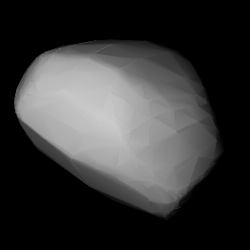Loading AI tools
From Wikipedia, the free encyclopedia
3749 Balam /ˈbeɪləm/ is a stony Flora asteroid and rare trinary system orbiting in the inner regions of asteroid belt. It also forms a secured asteroid pair with sub-kilometer sized asteroid (312497) 2009 BR60.[5] Balam was discovered on 24 January 1982, by American astronomer Edward Bowell at Lowell's Anderson Mesa Station near Flagstaff, Arizona, and received the prov. designation 1982 BG1. It was named after Canadian astronomer David Balam.[15] Balam measures approximately 4.1 kilometers (2.5 miles) in diameter.[5] Its two minor-planet moons have an estimated diameter of 1.66 and 1.84 kilometers, respectively.
 Shape model of Balam from its lightcurve | |
| Discovery [1] | |
|---|---|
| Discovered by | E. Bowell |
| Discovery site | Anderson Mesa Stn. |
| Discovery date | 24 January 1982 |
| Designations | |
| (3749) Balam | |
| Pronunciation | /ˈbeɪləm/ |
Named after | David Balam (Canadian astronomer)[2] |
| 1982 BG1 · 1954 XM 1962 ED · 1974 YO | |
| main-belt · Flora [3] | |
| Orbital characteristics [1] | |
| Epoch 4 September 2017 (JD 2458000.5) | |
| Uncertainty parameter 0 | |
| Observation arc | 61.66 yr (22,521 days) |
| Aphelion | 2.4818 AU |
| Perihelion | 1.9920 AU |
| 2.2369 AU | |
| Eccentricity | 0.1095 |
| 3.35 yr (1,222 days) | |
| 254.23° | |
| 0° 17m 40.56s / day | |
| Inclination | 5.3801° |
| 295.71° | |
| 173.74° | |
| Known satellites | 2 (⌀: 1.66 km; 1.84 km)[4] |
| Physical characteristics | |
| 4.1±0.5 km (primary)[5] 4.663±0.21 km (effective)[6][7] 4.7±0.5 km (effective)[8] | |
| Mass | (5.09±0.2)×1014 kg[9][10] |
Mean density | 2.61±0.45 g/cm3[9][10] |
| 2.805 h[11][12][13][lower-alpha 1] | |
| 0.16[14] 0.277±0.096[8] 0.355±0.067[6][7] | |
| Sq [13][14] | |
| 13.3[1] 13.4[6] 13.66[3][8][12][lower-alpha 1] | |
Balam is a member of the Flora family, a very large group of stony asteroids in the inner main-belt. It orbits the Sun in the inner main-belt at a distance of 2.0–2.5 AU once every 3 years and 4 months (1,222 days). Its orbit has an eccentricity of 0.11 and an inclination of 5° with respect to the ecliptic.[1]
It is named after the Canadian astronomer David Balam, principal observer at Victoria's Climenhaga Observatory in British Columbia.[2] The approved naming citation was published by the Minor Planet Center on 31 May 1988 (M.P.C. 13178).[16]
The S-type asteroid has an albedo of 0.16.[14] The body's rotation around its axis has been measured several times by different lightcurve observations with a concurring period of 2.8 hours.[11][12][13][lower-alpha 1]
On 13 February 2002, the discovery of a minor-planet moon, provisionally designated S/2002 (3749) 1, was announced by a team of researchers from SwRI, UA, JPL and OSUG, using the Gemini North Telescope on Mauna Kea in Hawaii.[17] It has an estimated diameter of 1.84 kilometers. It orbits 289±13 km away in 61±10 days, with a high orbital eccentricity of ~ 0.9. The distant and highly eccentric orbit of S/2002 (3749) 1 suggests that it was likely captured by Balam.[10]
Being such a small primary body in the inner main belt with a separation of over 100 primary radii, S/2002 (3749) 1 is the most loosely bound binary known.[18] Balam has a Hill sphere with a radius of about 1,500 kilometers.[10]
In March 2008, Franck Marchis discovered another companion, provisionally designated S/2008 (3749) 1, making Balam a trinary asteroid.[19][20] The inner satellite has a derived diameter of 1.66 kilometer, based on diameter-ratio of 0.42±0.03 with its primary.[4]
Other known trinary asteroids include 45 Eugenia, 87 Sylvia, 93 Minerva, 107 Camilla, 130 Elektra and 216 Kleopatra.
Balam also forms an asteroid pair with (312497) 2009 BR60.[5] Asteroid pairs are on highly similar heliocentric orbits. At some point in the past, the pair of asteroids became gravitationally unbound due to rotational fission induced by the YORP-effect or from a collisional breakup of the parent body. After the discovery of Balam's two satellites by Bill Merline (inner moon) and Franck Marchis (outer moon) in 2002 and 2008, respectively, Czech physicist David Vokrouhlický identified the unbound secondary in 2009. Based on backward orbit integrations, it is thought that Balam and 2009 BR60 form a secured asteroid pair that became separated approximately 400,000 years ago.[5]
Seamless Wikipedia browsing. On steroids.
Every time you click a link to Wikipedia, Wiktionary or Wikiquote in your browser's search results, it will show the modern Wikiwand interface.
Wikiwand extension is a five stars, simple, with minimum permission required to keep your browsing private, safe and transparent.